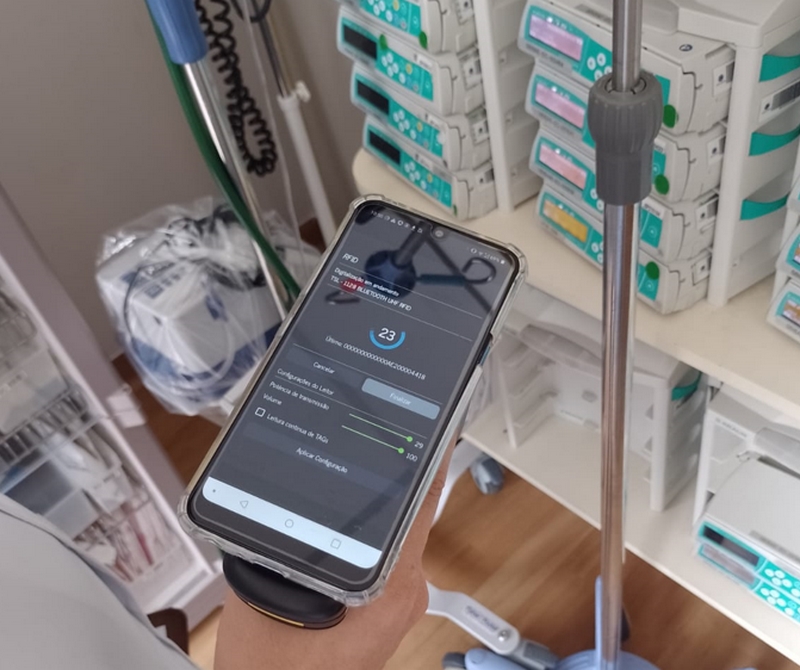Edson Perin
The Brazilian Hospital Israelita Albert Einstein became a finalist in the 2023 RFID Journal Awards thanks to its successful use of radio frequency identification (RFID) technology. The winners of the global award will be known on May 11, during the largest international RFID and Internet of Things (IoT) event, RFID Journal LIVE! 2023, in Orlando, Florida.
One of the organization’s greatest achievements includes reducing the loss of high-cost items. In addition, Einstein points out as direct benefits of implementing RFID the reduction of hospital trousseau inventory time, from 72 to 10 hours; the drop in the layette loss rate, from 4% to 0.8%; the decrease in the misuse of these items by 15%; and a 50% reduction in the number of employees assigned to the garment counting process.
The Hospital also accounts for a smaller need to replace new parts, due to the reduction in the evasion rate, with less time to find specific items and less time for the technical staff to manually search for medical equipment. As a result, the institution managed to increase the concentration of labor in health activities, its core activity. Other advantages with the use of RFID also involve greater accuracy in the readings of the equipment and a 10% reduction in the investment for the acquisition of room items.
The hospital team also points to indirect returns, such as the greater satisfaction of the laundry and clinical engineering teams; less time of unavailability of use of equipment with expired maintenance; greater engagement of teams in locating equipment that needs maintenance; more assertive distribution of equipment rental payments; and improvement in the management of items that go out for external maintenance or for use in other units of the institution.

Hospital Israelita Albert Einstein has 686 beds in the private system and 582 in the public system, in 22 private units and 29 public units that it manages. All use cases were developed mainly for the Morumbi unit, but some processes also run in other private units, such as Perdizes, Alphaville, Alto de Pinheiros, Anália Franco, Atlética, Francisco Morato, Ibirapuera, Jardins, Klabin, Parque da Cidade, Ibirapuera Park, Santana and Vila Mariana.
According to Rafael Vitolo, responsible for implementing and supporting Einstein’s RFID technology, “the room linen inventory service, which is carried out by the hotel and linen team, is also carried out on the premises of our partner laundry, located in the municipality of Caieiras (SP)”.
The Einstein Analyst states that RFID technology was implemented for five use cases within the hospital: trousseau control; location of medical equipment; control of fixed assets at the Teaching and Research Center – Campus Cecília and Abram Szajman; traceability of high cost items; and control of room items. “In each use case, we update or add new processes in the user areas”, says Vitolo.
“In the trousseau control, we changed the way the clothes are sent to the external laundry service, where we started to identify the shipment and return of the garments by means of RFID”, he explains. “We also optimized the inventory process, which used to be carried out by manually counting items and now the inventory is carried out using RFID readers, greatly optimizing execution time”.
Vitolo also explains that, for the Medical Equipment Location use case, the control and location processes were modified. “Several members of the clinical engineering team needed to blindly search for a certain piece of equipment for preventive maintenance and, now, they check the last location of a certain item in the system and go directly to the place to get the equipment”, he added. “In this use case, we also added a process called “Equipment Wanted”, which basically consists of alerting all those responsible via e-mail, when a sought item is seen through fixed portals or during readings through mobile devices”.
At the “Centro de Ensino e Pesquisa – Campus Cecília e Abram Szajman” (CEP), the process of inventorying fixed assets was also updated, which was previously carried out by manual identification and checking and now works with RFID technology.
“In order to achieve traceability of high-cost items, authentication processes during movements were added to the routine in the pharmacy area”, points out Vitolo. “Previously, when a high-cost item was requested via the system, the team separated the material and carried out the transport. Today, all these items are controlled by RFID tags. When a new request for material is made, the system triggers an integration informing about the need for reservation, the team separates the necessary material and authenticates in the RFID tunnel the items that were separated for this reservation”.
Furthermore, at the final destination, the same unitarized items must be authenticated as received and, if any items are missing or non-conforming items are identified, notifications are triggered. “All unauthorized movement of items is notified to those responsible,” he added.
The system in use by Hospital Israelita Albert Einstein was developed and implemented by the company SmartXHub. “For the High Cost Items Traceability use case,” reports Vitolo, “all tags are printed and saved in our environment. In this use case, we use the GRAI and SGTIN standard from GS1. As a result, any high-cost item, once coded, enabled the transfer of items between hospital units, the serialization of items and especially the automatic identification of an item or product from the decoding of the tags, thus identifying the EAN, company number and serial number, so that this information can be used at any stage of the traceability process”.
The fixed readers are installed in the internal areas of the Morumbi unit, where they monitor reception at the Pharmacy, Central Pharmacy, Surgical Kits Pharmacy, Surgical Pharmacies, Surgical Center, Obstetric Center, Clinical Engineering, Inpatient Units, Warehouse and Warehouse, Employee Exits and Patients, Central Linen, Dirty Linen SHUT. There are mobile collectors in all the institution’s premises, including external units and laundry providers, used during inventory processes.
Equipment in use includes 21 Impinj xSpam R660 RFID readers; four Impinj xArray RFID readers; 10 Impinj R420 RFID readers with four antennas; two HUB antenna + GPIO Impinj; 52 TSL-1128 portable readers with LG K12+ smartphone; two RFID Datamars reading booths; two SATO CL4NX RFID printers; and five RFID tunnels.
The Einstein park also includes the tags Impinj M730 Miniweb, Impinj Monza R6P RFID-MT-UHF-F8020, Alien Squiggle (Higgs-3), Datamars FT-401; and Impinj Monza R6P / E-62. “The tags used in the Traceability of High Cost Items use case are printed and recorded upon receipt of the material and discarded at the end of the life cycle of the respective product or item”, explains Vitolo.
The Einstein analyst also pointed out the challenges for reading to take place as planned. “The hospital environment is naturally complex and presents several physical challenges that are inherent to the use of RFID, some uncontrolled variables directly impact the tag reading performance. These challenges are mainly related to the characteristics of the materials, electromagnetic fields, various means of transport and condition of the items”.
According to Vitolo, the initial challenges were about the choice of tag and reader models for a hospital environment, the definition and standardization of the installation of tags on items, the resistance of these materials and, mainly, the sensitivity of reading in different scenarios and contexts of use. .
“Not limited to the physical issues of the tags and equipment”, pointed out Vitolo, “we also had challenges in processing the readings, due to the very high volume of capture of several tags simultaneously, we had to balance our middleware in two instances, develop filters of the EPCs of interest, create processing priority queues and implement algorithms to define the orientation and direction of the read tag”.
The Einstein professional also revealed that the use of active RFID technology was already common in the hospital in some services and processes. “The use of passive RFID technology [implanted by SmartXHub] arose from the specific business needs of each area that could not be met by active technology”.
“That was when the institution’s IT department”, he explained, “structured a concept that we called Passive and Multifunctional RFID Architecture, which sought to implement a middleware for shared use by all use cases. This allows us to leverage the use of the same reader for all use cases, reducing costs with new acquisitions, eliminating redundancies and enhancing the use of technology”.
About the next steps, Vitolo points out that, naturally, all use cases will undergo vegetative growth. “But the next steps are not limited to that, we are also developing new functionalities that will be incorporated into the use case “Standy Control”, where we will add management of the internal use of the items, as well as integration with a demand management system for work of the laundry workers”.
In addition, he says, “we started studies on the implementation of Fixed Asset Control in the institution’s other private units. We also have studies for the adoption of other IoT technologies in our processes, such as LORA, BLE, among others”.
RFID technology is integrated into the management system (ERP) used by Einstein. “For the use case Traceability of High Cost Items, an integration layer with SAP was built. When a material reservation request is made by the ERP, and in this reservation there are items that are controlled by RFID, an integration is triggered indicating the reservation that must be authenticated in the RFID tunnel before transport”, explained Vitolo.
“In our RFP [request for proposal] process, we looked for a middleware that would be able to communicate and obtain readings from the most diverse models of RFID readers on the market, as we created the concept that this should support several use cases in the same environment”, he attested. “During the technical evaluation process of the proposals, the middleware developed by SmartxHUB was approved. Our strategic partner for the entire implementation is IDvida IOT, which represents and supports the solutions developed by SmartxHUB USA in Brazil”.
“After we defined in the RFP, the design of how the entire RFID architecture should be, the supplier’s role was to develop, deploy and support the entire solution, including middleware applications of the use case, approval of equipment and tags”, he pointed out.
To get to know SmartXHub, Einstein made use of a market competition and chose this solution, among the various proposals, based on its technical and commercial criteria. IDvida IOT, which represents SmartXHub, was the technically and commercially selected company”.
Implementing RFID was a positive experience for the organization, with many lessons learned and challenges overcome. According to Vitolo, the final experience was very positive. “All the use cases were implemented, the performance indicators of the areas were optimized, we have teams engaged in the use of technology and the consequent benefits they bring us”.
And he added: “perhaps the biggest challenge has been to reconcile a robust and structured architecture to support an average volume of 3 million readings performed by almost 100 devices, including mobile readers and collectors, which update 30,000 items daily, we control more than 300,000 assets, distributed in 273,000m² linked to 1,212 zones, we manage and send 900 monthly alerts to approximately 200 direct end users”.



















